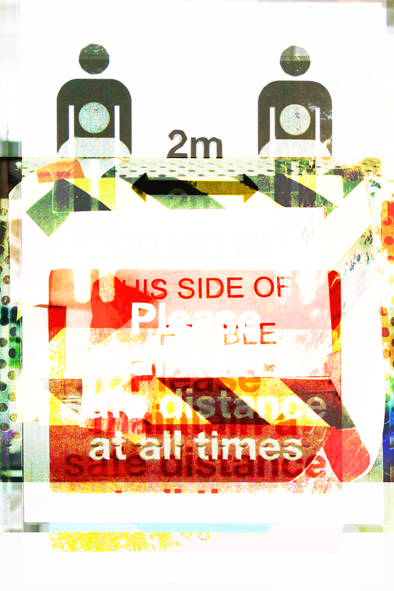 |
'Untitled 5 (Constructed City', Acrylics on Panel, 60 cm x 60 cm, 2020
|
In my never-ending quest to rediscover increased productivity, I've returned to having several related pieces in progress simultaneously. Thus, I currently have several 'Constructed City' paintings in play, with yet more panels also in preparation. Inevitably though, some still reach whatever passes for completion faster than others - as, I now realise, is the case with this one.
It's always useful to identify the productive modus operandi most appropriate to a particular body of work. In the case of these painstakingly masked, and methodically applied 'CC' paintings, having several on the go at once seems to make sense. Put simply - while one coat of paint is drying, another can be masked, or painted upon unimpeded. A deliberately methodical demeanour, and careful time management, both seem appropriate to the mode of their execution. It's not unlike how things proceed on a large building project, either.

In certain respects, 'Untitled 5' resembles its immediate predecessor. However, there are distinct differences too. My hope is that this next little bunch of paintings will represent a more concerted development of some of the ideas and approaches I've been tentatively groping towards for a while. The first four 'CC' paintings derived from sketchbook-based photographic collages, and retained a degree of collage in their final execution. There was also a certain figure-and-ground relationship about them. However, this new image originated in a far more digital manner, and exhibits more of an all-over, on-the-surface aspect.
 |
Digital Study ('Constructed City'), 2020
|
In essence, this has a lot to do with the relationship between abstraction and representation, I think. When this 'Constructed City' project started, over a year ago, it was envisaged as a largely print-based undertaking. For me, printing and photography (and the relationship between them) are the arenas in which I feel most comfortable dealing with representational issues. Painting is the field in which things automatically seem to default to the abstract - and often with a some greater accompanying sense of distillation. As lockdown conditions dictated a move away from shared print studio activities, earlier in the year (and as will presumably continue to be the case again, for a while), shifting the focus to painting seemed the easiest way to keep generating new imagery. However, I now wonder if some of the frustrations and stuttering workflow, of which I've often complained, might be partly because simply switching media like that often requires fmore reflection than one (I) might have lazily predicted. I really should know this stuff by now.

Whatever the real intricacies of that may be, this slightly revised approach currently feels like a more natural one for me to pursue in paint. The imagery still descends from specific photographs. However, the considerable degrees of editing and distillation wrought upon them in Photoshop, prior to going anywhere near a painting panel, means I'm already far more comfortably in the formal/abstract domain by the time that does occur.
There is certainly a sense in which this painting still resembles some red shapes distributed across a vaguely modulated ground. However, it should be pointed out that those shapes mostly represent negative spaces (sections of sky or other distant elements, glimpsed between steelwork or scaffolding) in the original photographic reference. They've been through the digital mincer more than once, to reach their current simplified state, but even in this form, there remains some sense of layering (relating to Photoshop layers - rather than physically collaged photos or prints, in this case).

What does feel vital, is the degree to which spatial ambiguity can be accentuated within future variations. It feels important that those shapes should retain the potential to appear punched through the surrounding 'ground', at least as much as they appear to float above it. In fact, an ideal situation would be one in which either/both states might suggest themselves simultaneously, and positive and negative spaces thus toggle back and forth. The layering, meshing, overlapping, and interlocking of complex screens of visual information is a major function of the way that the construction sites appear, and one which can leave the eye struggling to make coherent sense of it all . That's as true (if not more so) of after-the-event analysis of photographic reference, as of first impressions, and definitely something I was playing with in earlier sketchbook-bound composites.

As I've already suggested, the real challenge now seems to be one of finding the best way to negotiate the translation from photography to painting. If the screen prints and collages could comfortably fall back on a higher degree of representation (and indeed, benefit from it in terms of juxtaposed realities), this resort to purer, more formal abstraction feels more appropriate now. That's certainly true if I'm to avoid descending into unnecessarily pedestrian and ultimately unsatisfying attempts to paint 'realistically'. Work to your proven strengths - not your weaknesses, and leave that kind of thing to others who do it far better - I say.

In this respect, it's worth highlighting the greater degree of specificity now at work in these scattered red shapes. It may make them a bugger to mask, but the intricacies of their contours, and vestigial references to certain recognisable details now seem preferable to the more generalised patterns that appeared in 'Untitled 1 - 4 (CC)'. Clearly, this is because the shapes themselves are doing more heavy lifting regarding the original subject matter, now that photographic or photo-derived printed elements have receded. The relationship between representation and abstraction is still there, as is the potential to juxtapose layers of meaning and/or visual reference. For now, however, this feels like a slightly more refined or integrated way to achieve it.
There are more of these coming along fairly close behind, so hopefully it won't be too long before I can tell if this really is the small breakthrough it currently feels like.




























